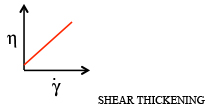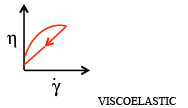Coating Matters | The Effects of Viscoelastic Behavior, Pt. 1
- Published: May 26, 2015, By Mark Miller
If you'd like to hear from Mark Miller's own lips rather than read his column, titled "Coating Matters | The Effects of Viscoelastic Behavior," click on his podcast below:
{mp3}effects-of-viscoelastic-behavior-voice{/mp3}
When coating a fluid, consideration of the rubbery behavior needs to be given with the shear rate versus viscosity data
![]() Coating rubber bands is not easy. So when you look at coating liquids that have molecules already formed, or the fluid has a rubbery nature, care needs to be taken to consider the effects of viscoelastic behavior.
Coating rubber bands is not easy. So when you look at coating liquids that have molecules already formed, or the fluid has a rubbery nature, care needs to be taken to consider the effects of viscoelastic behavior.
Viscoelasticity is the fluid’s reaction to being deformed both in viscosity and elasticity. Some fluids have only viscosity changes under shear, but more complex fluids want to snap back after deformation. In other words, when coating a fluid, consideration of the rubbery behavior needs to be considered with the shear rate versus viscosity data.
What does this viscoelastic nature look like? If you study a fluid that has shear thinning characteristics, but not elastic characteristics, then the viscosity curve has no hysteresis—the curve looks the same as shear force is applied and removed. For a viscoelastic fluid, the liquid acts differently under shear force than when the force is removed. This stress-relaxation behavior can affect the flow dynamics of the fluid as it goes through expansion and contraction zones, or stresses from film split act on the fluid.


Different coating techniques require different considerations with viscoelastic fluids. Roll coating techniques need to consider the film split of the fluid as rotational forces interact with tensioned web movement. Premetered coating techniques (like slot die technology) contract and expand the fluid within given physical dimensions that can affect the fluid flow of viscoelastic fluids.
Complex flow calls for complex analysis. If we want to understand the viscous and the elastic behavior of the fluid, we can’t rely on a simple rheological study. Zahn cup or Brookfield viscosity methods are helpful for simple fluids and simple coatings, but oscillitory rheometer testing is required to obtain shear rate versus viscosity testing.
Complex rheology testing provides the storage (G’) and loss (G”) modulus for the fluid. It is best to think of these factors as analogous to a spring constant. If you take a spring (or coil) and pull it tight, there would be a larger amount of potential energy (or storage modulus: G’). If the spring relaxes, the loss modulus (G”) asserts itself over the storage modulus. If the loss or storage modulus does not show dependence on time, then the elastic nature of the fluid is stronger than the shear nature of the fluid. To further understand the elastic nature, elongational testing needs to be completed.
So what do you do if the elastic nature of the fluid dominates the viscous nature of the fluid? A new set of coating defects appear that need to be viewed from this elastic perspective. In roll coating, misting and roll spatter will occur due to failure to properly split the resultant film. In premetered coating the slot die needs to control the flow of fluid internally to allow the liquid to move evenly out of the final slot opening with reduced shear forces. If forces on the slot die are not controlled, the fluid will retract after coating and may cause wrinkling, curl, or voiding. In addition, die swell will occur and cause potential edge beads.
With standard fluids there is some level of self-leveling that occurs, but with viscoelastic fluids the movement to fill the space is reduced. Self-leveling fluids are like water—you pour them onto the substrate and the water will follow the contours of the surface. Viscoelastic fluids flow like a rubber band or gelatin—you have to force the shape with additional concerns based on rubbery retraction.
When you are dealing with viscoelastic fluids, be sure to understand how these higher molecular weight polymer systems respond to forces in order to counteract the resultant coating defects. Control the fluid with reduced shear or formulate the fluids to reduce elastic snap-back effects.
 Mark D. Miller, author of PFFC's Coating Matters column, is a fluid coating expert with experience and knowledge in the converting industry accumulated since 1996. Mark holds a Bachelor's degree in Chemical Engineering from the Univ. of Wisconsin-Madison and a Master's degree in Polymer Science & Engineering from Lehigh Univ. and a Juris Doctor from Hamline Univ. Mark is a technical consultant and CEO of Coating Tech Service LLC. He has worked in web coating technologies and chemical manufacturing operations and is a certified Six Sigma Black Belt trained in both DMAIC and DFSS disciplines. Coating Tech Service provides process troubleshooting and project management for precision coated products. Mark has extensive process knowledge in high precision coating applications including thin film photo voltaic, Li-Ion battery, and optical systems technology. Mark has been integral to new developments and technology that minimize product waste and improve process scalability.
Mark D. Miller, author of PFFC's Coating Matters column, is a fluid coating expert with experience and knowledge in the converting industry accumulated since 1996. Mark holds a Bachelor's degree in Chemical Engineering from the Univ. of Wisconsin-Madison and a Master's degree in Polymer Science & Engineering from Lehigh Univ. and a Juris Doctor from Hamline Univ. Mark is a technical consultant and CEO of Coating Tech Service LLC. He has worked in web coating technologies and chemical manufacturing operations and is a certified Six Sigma Black Belt trained in both DMAIC and DFSS disciplines. Coating Tech Service provides process troubleshooting and project management for precision coated products. Mark has extensive process knowledge in high precision coating applications including thin film photo voltaic, Li-Ion battery, and optical systems technology. Mark has been integral to new developments and technology that minimize product waste and improve process scalability.




